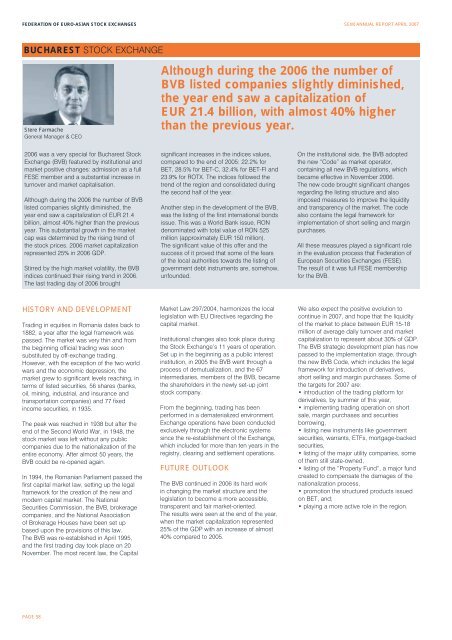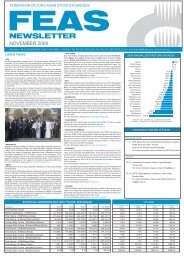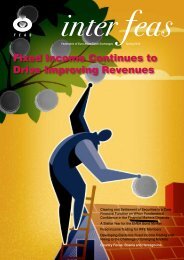Download - FEAS
Download - FEAS
Download - FEAS
Create successful ePaper yourself
Turn your PDF publications into a flip-book with our unique Google optimized e-Paper software.
FEDERATION OF EURO-ASIAN STOCK EXCHANGES SEMI ANNUAL REPORT APRIL 2007<br />
BUCHAREST STOCK EXCHANGE<br />
Stere Farmache<br />
General Manager & CEO<br />
Although during the 2006 the number of<br />
BVB listed companies slightly diminished,<br />
the year end saw a capitalization of<br />
EUR 21.4 billion, with almost 40% higher<br />
than the previous year.<br />
2006 was a very special for Bucharest Stock<br />
Exchange (BVB) featured by institutional and<br />
market positive changes: admission as a full<br />
FESE member and a substantial increase in<br />
turnover and market capitalisation.<br />
Although during the 2006 the number of BVB<br />
listed companies slightly diminished, the<br />
year end saw a capitalization of EUR 21.4<br />
billion, almost 40% higher than the previous<br />
year. This substantial growth in the market<br />
cap was determined by the rising trend of<br />
the stock prices. 2006 market capitalization<br />
represented 25% in 2006 GDP.<br />
Stirred by the high market volatility, the BVB<br />
indices continued their rising trend in 2006.<br />
The last trading day of 2006 brought<br />
significant increases in the indices values,<br />
compared to the end of 2005: 22.2% for<br />
BET, 28.5% for BET-C, 32.4% for BET-FI and<br />
23.9% for ROTX. The indices followed the<br />
trend of the region and consolidated during<br />
the second half of the year.<br />
Another step in the development of the BVB,<br />
was the listing of the first international bonds<br />
issue. This was a World Bank issue, RON<br />
denominated with total value of RON 525<br />
million (approximately EUR 150 million).<br />
The significant value of this offer and the<br />
success of it proved that some of the fears<br />
of the local authorities towards the listing of<br />
government debt instruments are, somehow,<br />
unfounded.<br />
On the institutional side, the BVB adopted<br />
the new “Code” as market operator,<br />
containing all new BVB regulations, which<br />
became effective in November 2006.<br />
The new code brought significant changes<br />
regarding the listing structure and also<br />
imposed measures to improve the liquidity<br />
and transparency of the market. The code<br />
also contains the legal framework for<br />
implementation of short selling and margin<br />
purchases.<br />
All these measures played a significant role<br />
in the evaluation process that Federation of<br />
European Securities Exchanges (FESE).<br />
The result of it was full FESE membership<br />
for the BVB.<br />
HISTORY AND DEVELOPMENT<br />
Trading in equities in Romania dates back to<br />
1882, a year after the legal framework was<br />
passed. The market was very thin and from<br />
the beginning official trading was soon<br />
substituted by off-exchange trading.<br />
However, with the exception of the two world<br />
wars and the economic depression, the<br />
market grew to significant levels reaching, in<br />
terms of listed securities, 56 shares (banks,<br />
oil, mining, industrial, and insurance and<br />
transportation companies) and 77 fixed<br />
income securities, in 1935.<br />
The peak was reached in 1938 but after the<br />
end of the Second World War, in 1948, the<br />
stock market was left without any public<br />
companies due to the nationalization of the<br />
entire economy. After almost 50 years, the<br />
BVB could be re-opened again.<br />
In 1994, the Romanian Parliament passed the<br />
first capital market law, setting up the legal<br />
framework for the creation of the new and<br />
modern capital market. The National<br />
Securities Commission, the BVB, brokerage<br />
companies, and the National Association<br />
of Brokerage Houses have been set up<br />
based upon the provisions of this law.<br />
The BVB was re-established in April 1995,<br />
and the first trading day took place on 20<br />
November. The most recent law, the Capital<br />
Market Law 297/2004, harmonizes the local<br />
legislation with EU Directives regarding the<br />
capital market.<br />
Institutional changes also took place during<br />
the Stock Exchange’s 11 years of operation.<br />
Set up in the beginning as a public interest<br />
institution, in 2005 the BVB went through a<br />
process of demutualization, and the 67<br />
intermediaries, members of the BVB, became<br />
the shareholders in the newly set-up joint<br />
stock company.<br />
From the beginning, trading has been<br />
performed in a dematerialized environment.<br />
Exchange operations have been conducted<br />
exclusively through the electronic systems<br />
since the re-establishment of the Exchange,<br />
which included for more than ten years in the<br />
registry, clearing and settlement operations.<br />
FUTURE OUTLOOK<br />
The BVB continued in 2006 its hard work<br />
in changing the market structure and the<br />
legislation to become a more accessible,<br />
transparent and fair market-oriented.<br />
The results were seen at the end of the year,<br />
when the market capitalization represented<br />
25% of the GDP with an increase of almost<br />
40% compared to 2005.<br />
We also expect the positive evolution to<br />
continue in 2007, and hope that the liquidity<br />
of the market to place between EUR 15-18<br />
million of average daily turnover and market<br />
capitalization to represent about 30% of GDP.<br />
The BVB strategic development plan has now<br />
passed to the implementation stage, through<br />
the new BVB Code, which includes the legal<br />
framework for introduction of derivatives,<br />
short selling and margin purchases. Some of<br />
the targets for 2007 are:<br />
• introduction of the trading platform for<br />
derivatives, by summer of this year,<br />
• implementing trading operation on short<br />
sale, margin purchases and securities<br />
borrowing,<br />
• listing new instruments like government<br />
securities, warrants, ETFs, mortgage-backed<br />
securities,<br />
• listing of the major utility companies, some<br />
of them still state-owned,<br />
• listing of the “Property Fund”, a major fund<br />
created to compensate the damages of the<br />
nationalization process,<br />
• promotion the structured products issued<br />
on BET, and;<br />
• playing a more active role in the region.<br />
PAGE 58
















